I don’t own a food dehydrator (yet), so when I’m looking for more ways to preserve my garden produce that won’t take up space in the freezer or require me to stack canning jars in the laundry room closet, I turn to drying.
Specifically, oven drying.
It takes longer than a dehydrator, but it’s a fairly hands-off process and works just as well for drying herbs (like oregano) as it does for drying tomatoes.
(Especially since I’ve already turned those tomatoes into fermented salsa, tomato sauce with skins on, tomato sauce infused with tomato leaves, and frozen whole tomatoes.)
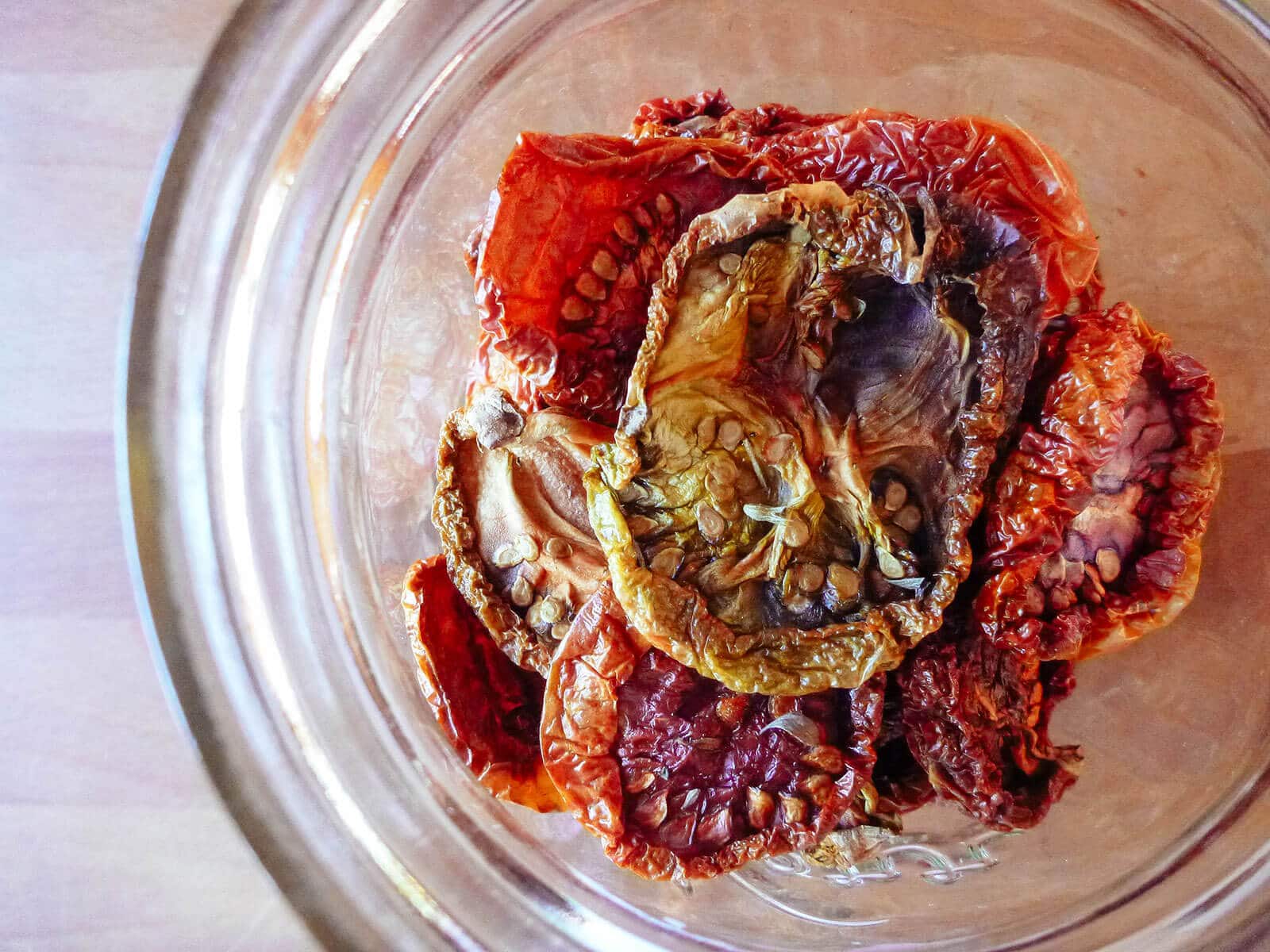
Oven-dried versus sun-dried tomatoes: what’s better?
Have you ever tried to dehydrate tomatoes in the oven?
Let me tell you—once you’ve had a taste of your ripe, tangy heirloom tomatoes oven-dried at home, you’ll never go back to that inferior, expensive, store-bought sun-dried stuff.
That wrinkly little nub of tomato packs a serious punch, with an intense, zesty flavor so concentrated that it makes magic out of the simplest sauce and adds gusto to any dish.
Sure, you could do it the old-fashioned way, and let your tomatoes sit around for a few days in the blazing hot sun until they shrivel up.
Naturally sun-dried (or air-dried) tomatoes are a romantic notion, and I wish I was patient enough to wait that long or watchful enough to guard those goodies against backyard critters. (The sun-drying method takes anywhere from five days up to two weeks.)
In contrast, you can make sun-dried tomatoes fast using a conventional gas or electric oven.
Oven-dried tomatoes take less than 24 hours and by the end of the day (a very long day), my kitchen smells amazing and I’m rewarded with clusters of deliciously wizened tomatoes that I can enjoy well beyond their harvest.
As a bonus, you can preserve a mountain of tomatoes easily and neatly into just one or two quart-sized jars.
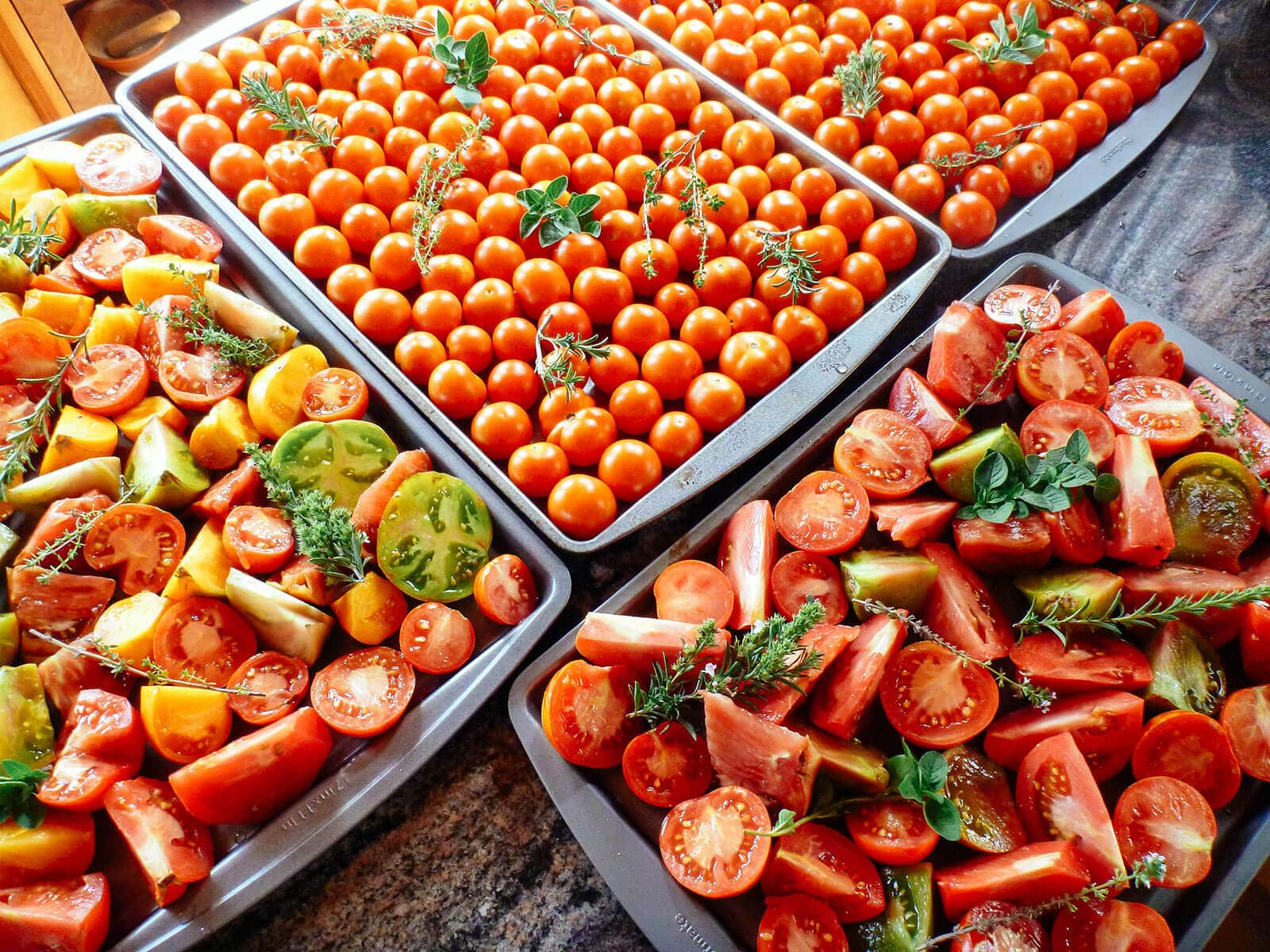
What are the best tomatoes for drying?
Small, dense tomatoes are most ideal for oven drying, sun drying, and dehydrating. These include pear-shaped varieties and plum tomatoes (also called Roma or paste tomatoes).
A particular heirloom grape variety called Principe Borghese is especially well-suited to drying because its meaty texture is drier than most.
But, I’ve had great success with petite round tomatoes as well as larger slicing types, so use what you have!
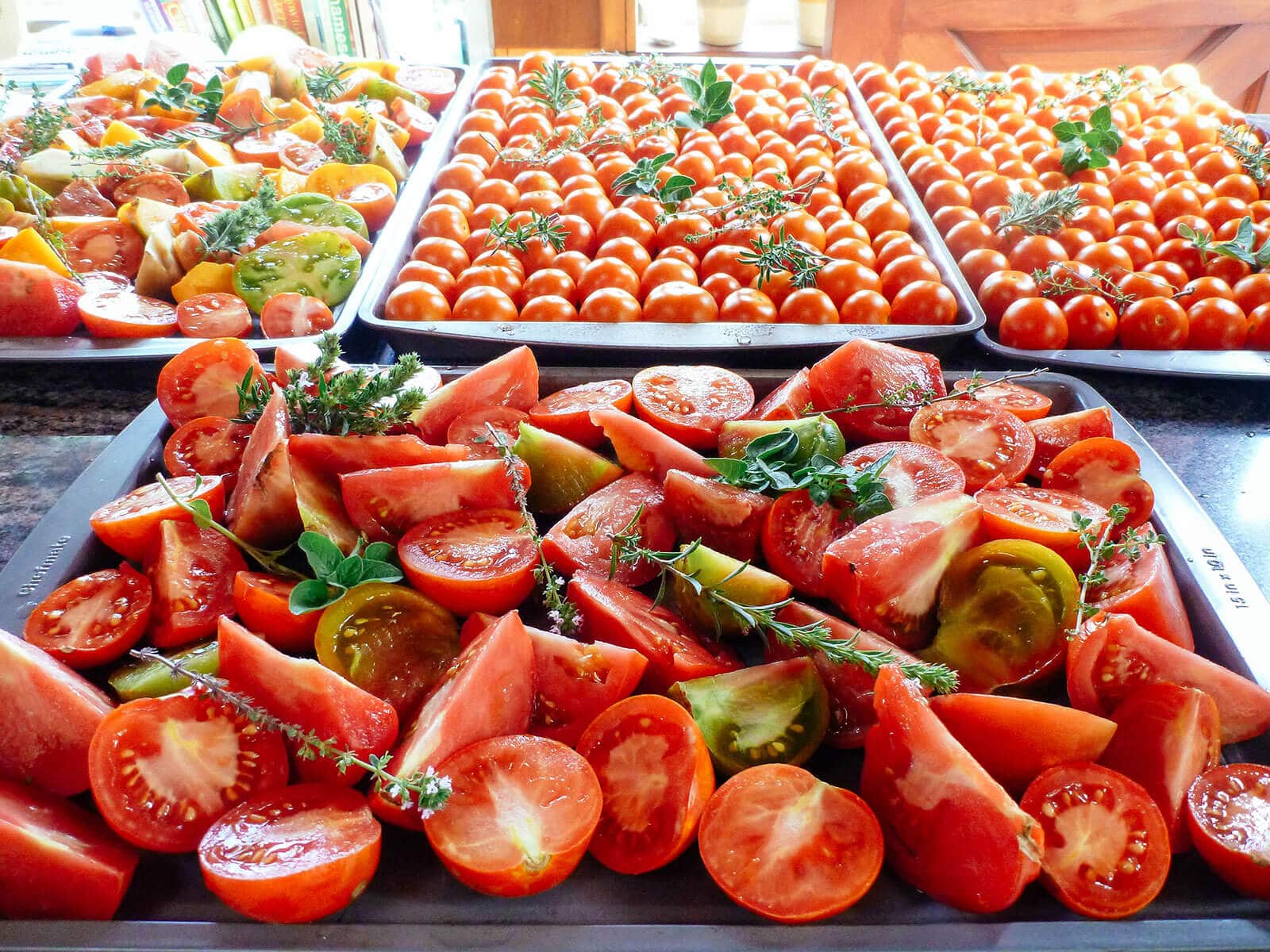
How to make sun-dried tomatoes in the oven
Not speaking from experience or anythiiiing… but you do not want to start this project in the middle of your day, lest you want to be awake at 4 am monitoring and cursing your oven (and if you do, you might have to bribe a housemate to take a shift… so you should gather more tomatoes, just in case).
Disclosure: If you shop from my article or make a purchase through one of my links, I may receive commissions on some of the products I recommend.
Start with your best ripe tomatoes. Depending on the size of your fruit, halve or quarter them, or cut them into thick slices and wedges (about 1/2 to 3/4 inch) if they’re especially large. Cherry and grape tomatoes can be oven-dried whole.
Arrange your tomatoes on large baking sheets, skin sides down and barely touching. If you have oven-safe cooling racks, you can place them over the baking sheet firsts for maximum air flow around the tomatoes, which will speed up the drying process.
Quick tip: Place tomatoes of similar thicknesses together on the same baking sheet. They’ll generally dry at the same rate, so they’ll be easier to pick off and pull out of the oven.
Sprinkle the tomatoes sparingly with salt—I like to use flaky sea salt or Himalayan pink salt. Remember that your tomatoes will lose around 90 to 95 percent of their moisture in the oven, so any salt you use will become concentrated in what’s left of the tomatoes.
Add your favorite herbs right on top—I used a few sprigs of fresh oregano, winter savory, and lemon thyme on mine, but you can also try rosemary, basil, marjoram, chives, or whatever you have on hand.
Preheat your oven to its lowest temperature setting (between 175°F to 190°F—sometimes this will simply be the “warm” setting).
If your oven’s lowest setting is 200°F or more, you can prop the door open slightly with a wooden utensil to regulate temperature and moisture evaporation.

And then… you go about your day like normal. Check the oven every couple of hours until the edges of the tomatoes start to curl in and the centers start to pucker.
At this point, you’ll need to check every hour or less. You want a raisin-y texture—fully dry, but still pliable and leathery to the touch.
You’ll know the tomatoes are fully dry when you press down on them and no juices seep out. Be careful that you don’t dry them too much that they become brittle. (The perfect oven-dried tomato stays pleasantly chewy.)
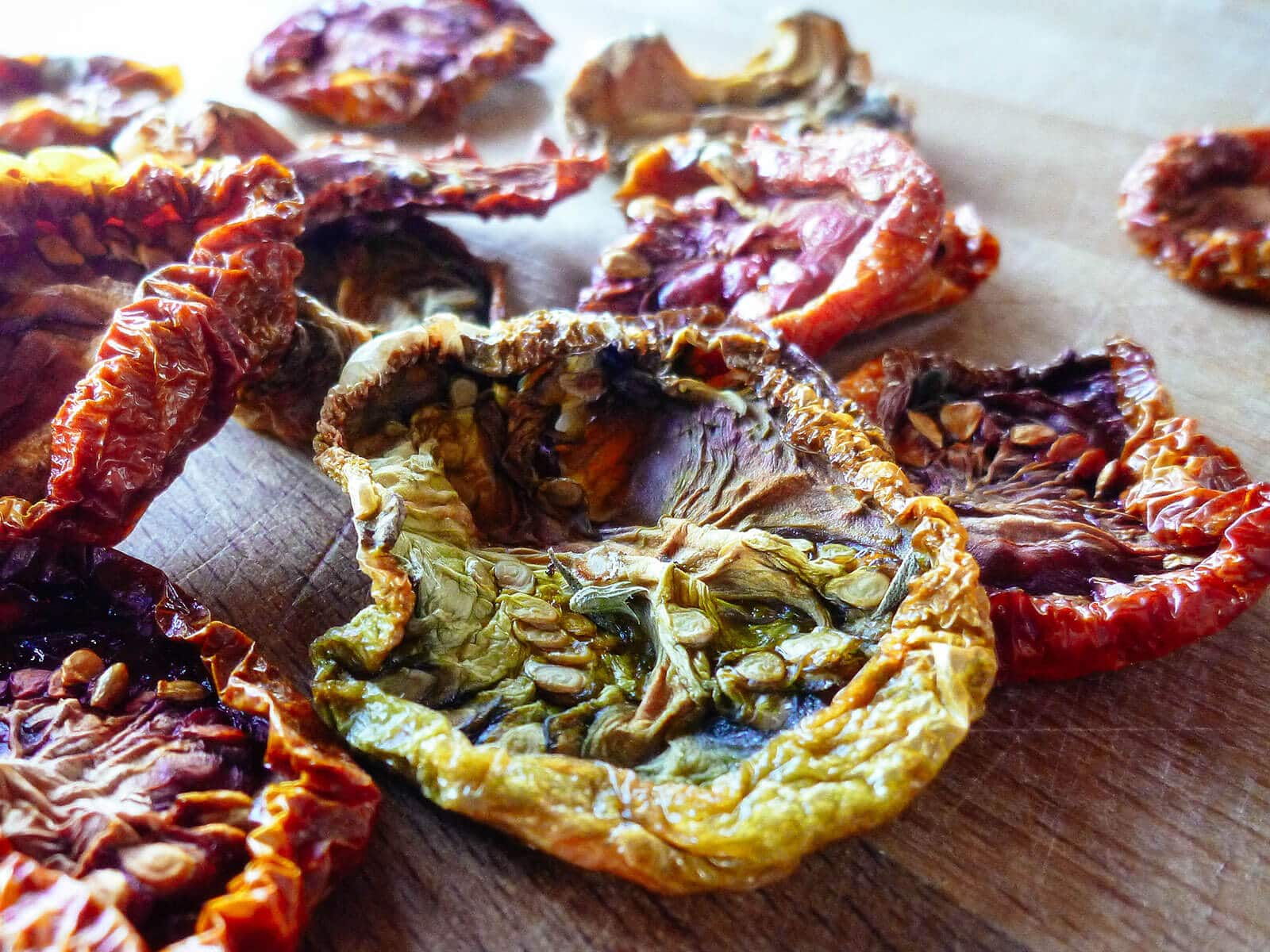
Smaller chunks will dry faster than larger and thicker ones, so I pick these off the baking sheet individually and leave them out to cool.
When all the tomatoes have finished drying, remove them from the oven and allow the batch to cool completely.
At 175°F, my tomatoes took 12 hours to thoroughly dry. In the last hour or two, only a few of my thicker and juicier wedges remained on the baking sheet.
I have read reports of oven-dried tomatoes taking anywhere from 6 to 24 hours, so your mileage will vary. A newer convection oven would likely move things along more speedily over an older conventional oven.
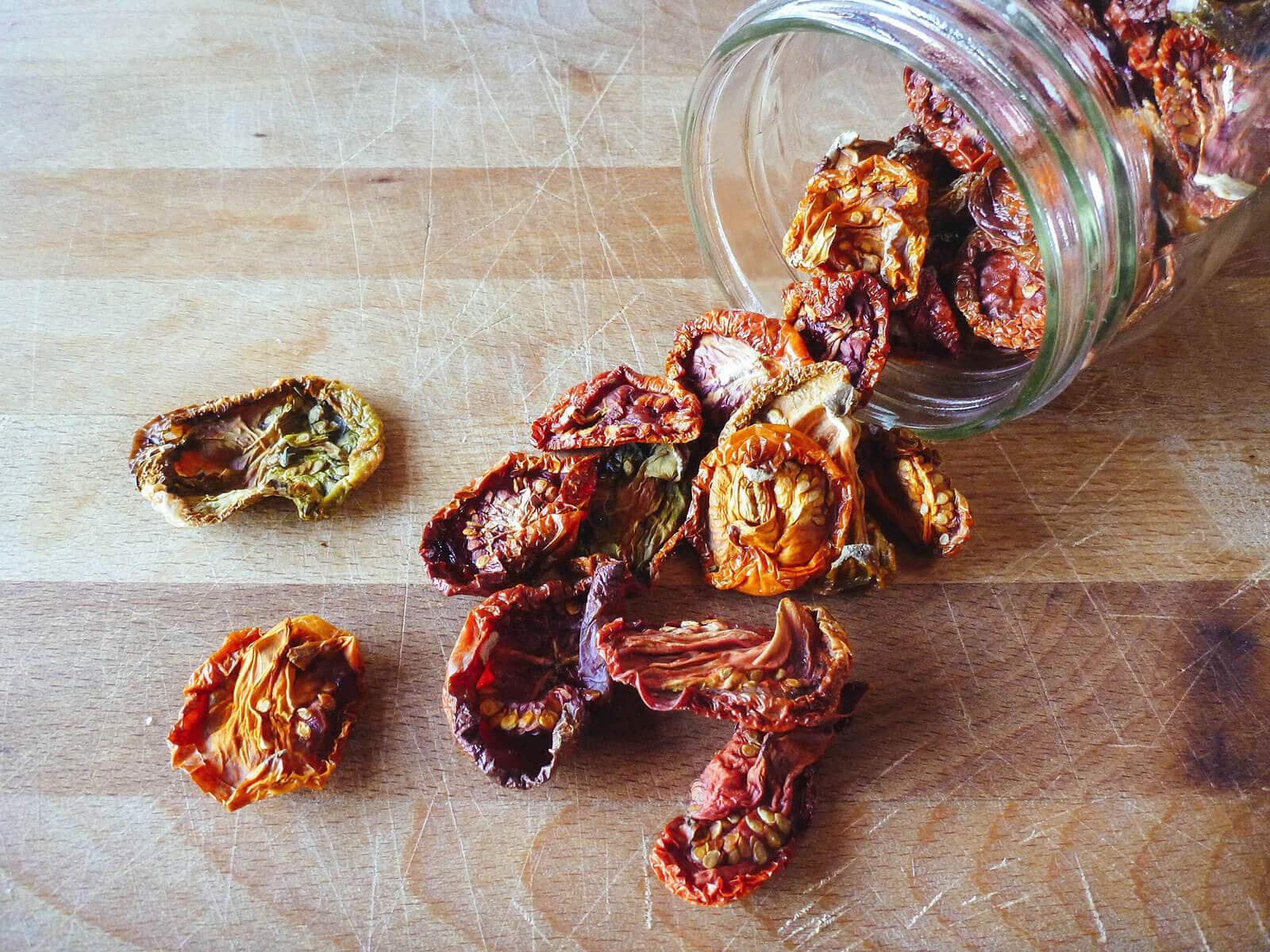
How to store oven-dried or sun-dried tomatoes
Dry-packing method
Once fully dry, you can store the tomatoes in clean jars in a cool, dark place. (I love these dark amber glass jars that help preserve the tomatoes longer.)
They should last for at least six months, after which they may start to decline in quality.
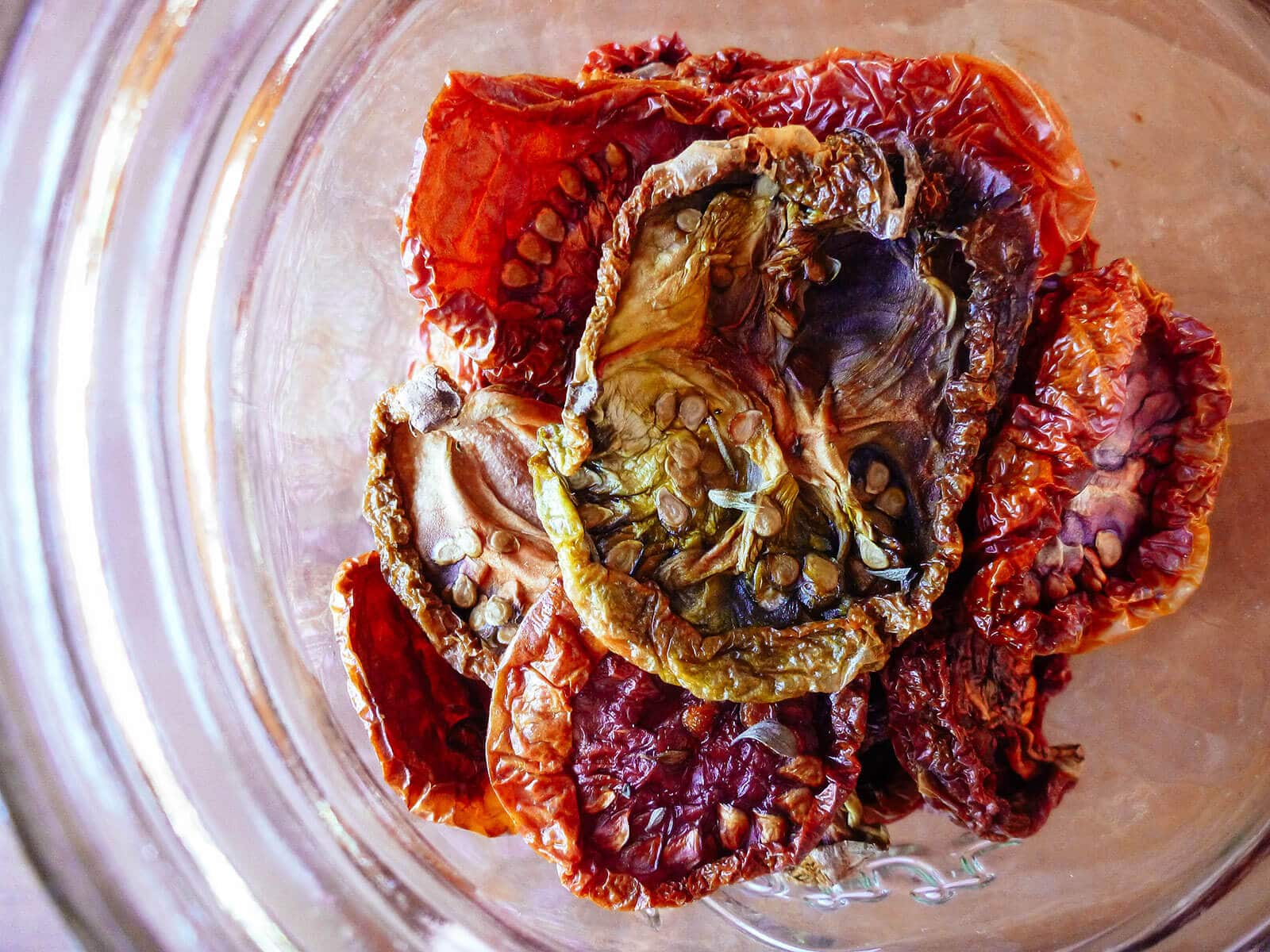
Oil-packing method
You can also pack oven-dried tomatoes in good-quality extra-virgin olive oil, with the benefit that you can use the leftover tomato-infused oil to make some tasty vinaigrettes or marinades.
Oil-packed tomatoes should be stored in the fridge, where they’ll keep for about six months. The oil may start to congeal and turn cloudy, but return to its normal state at room temperature. This is completely normal and does not affect the flavor or quality of the oil or tomatoes.
If you didn’t add herbs (or used only dried herbs) to your tomatoes, you can safely store them in oil at room temperature—no refrigeration necessary (though refrigerating them will delay rancidity).
According to OSU Extension Service:
Because of their acidity, unseasoned (i.e., no vegetables or herbs) fully dried tomatoes may be safely stored in oil at room temperature. (Refrigeration may delay rancidity, however). The tomatoes will soften more if quickly dipped in bottled lemon or lime juice before being placed in the oil. The tomatoes can be flavored with dried herbs and garlic. NOTE: Dried tomatoes-in-oil mixtures with garlic and/or herbs MUST be refrigerated and used within 4 days or frozen for long-term storage.
(Note the last part where OSU mentions dried tomatoes in oil with garlic. I don’t recommend adding garlic when you season your tomatoes, due to the risk of botulism when they’re kept in oil.)
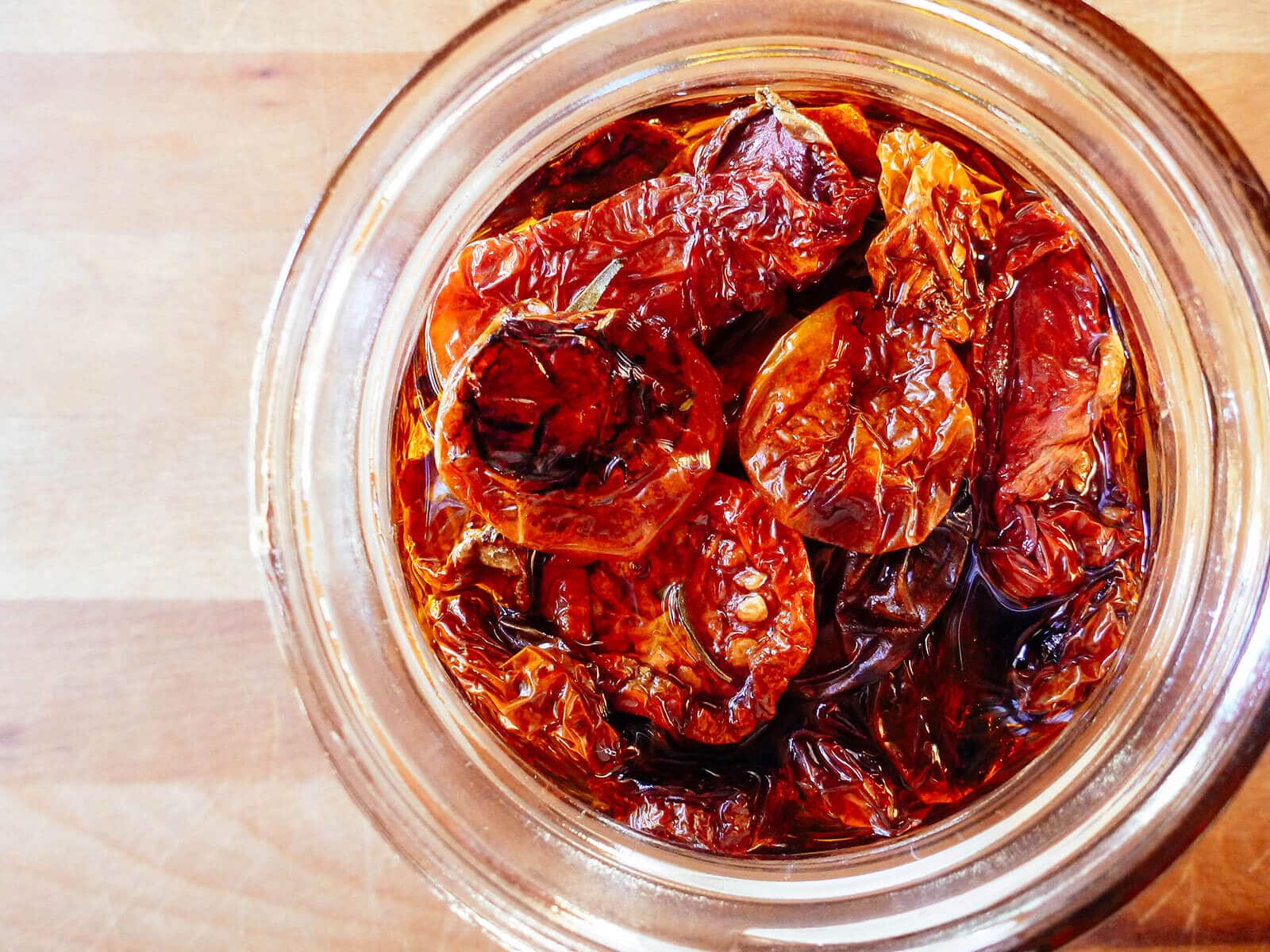
Freezing method
If you like to leave a little moisture in your oven-dried tomatoes, you should freeze them so they don’t spoil. Put them in a vacuum-sealed pouch, or in a zip-top bag with all the air sucked out using a straw, and store in the freezer for up to a year.
When thawed, frozen oven-dried tomatoes will lose their nice, leathery texture, so they’re best cooked into recipes.
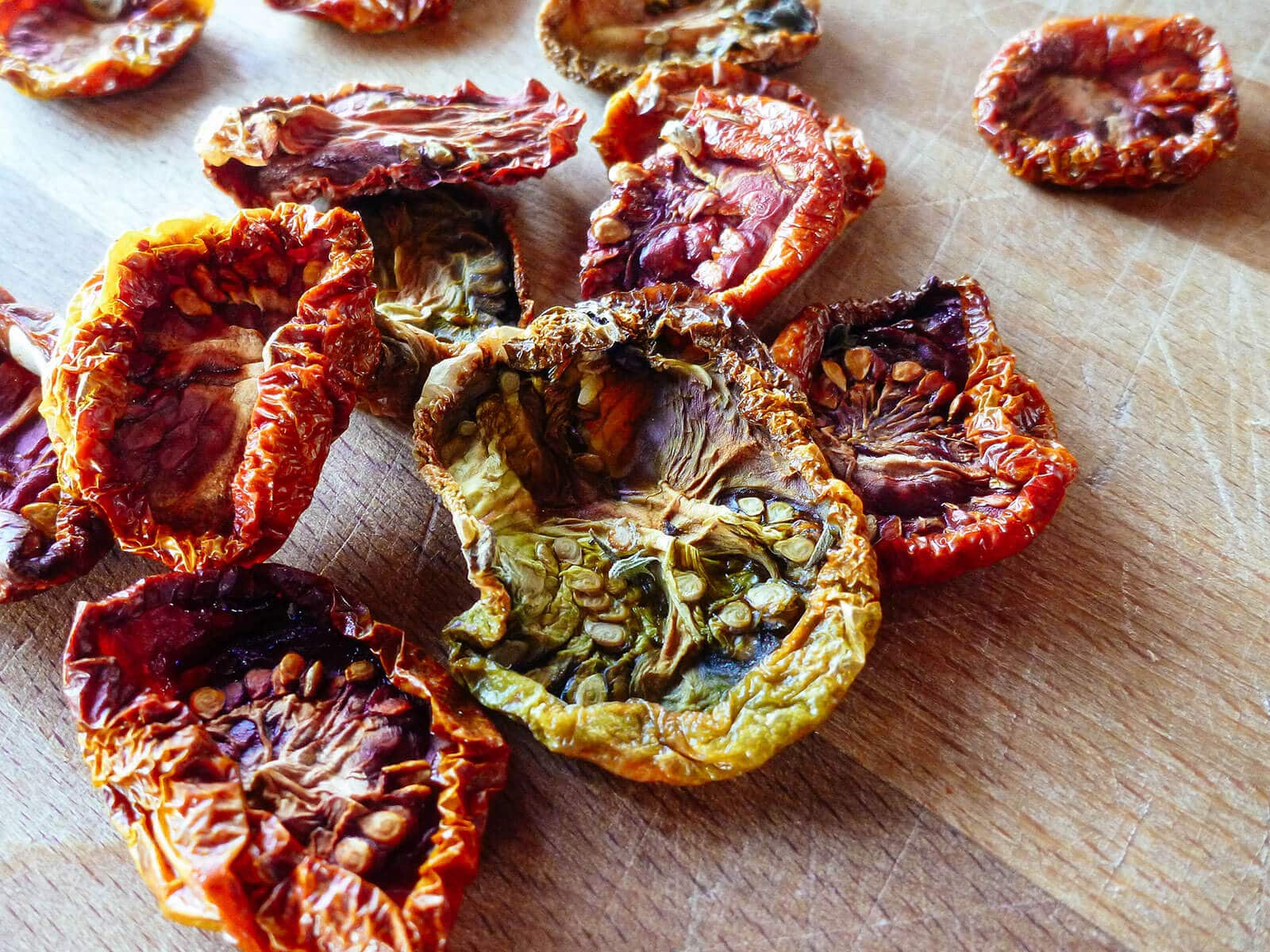
What do you do with oven-dried or sun-dried tomatoes?
I delved into my oven-dried tomatoes the same day I packed them into jars. They were delicious on a deli sandwich, added just the right oomph when chopped and mixed with canned sardines (which I spooned onto crackers), and made for killer pasta sauce.
You can also use them in or on:
- Sun-dried tomato pesto
- Compound butter
- Dips and sauces
- Tapenades
- Salad dressings
- Marinades
- Antipasto
- Charcuterie platters
- Bruschetta
- Burgers
- Meatballs
- Pizzas
- Pastas
- Pasta salads
- Risotto
- Frittatas
- Omelets
- Scrambled eggs
- Mashed potatoes
- Baked potatoes
Or… just straight out of the jar! How do you like to eat oven-dried or sun-dried tomatoes?
Where to buy tomato drying supplies
[show_shopthepost_widget id=”4141467″]
Kitchenatics Commercial Grade Stainless Steel Cooling Rack | Kitchenatics Half Sheet Pan and Oven-Safe Rack Set | Maldon Sea Salt Flakes | San Francisco Salt Co. Sherpa Pink Himalayan Salt | La Tourangelle Organic Extra Virgin Olive Oil | Ball Wide-Mouth Amber Glass Quart Jars | Ball Wide-Mouth Leak-Proof Storage Lids
How to Make Sun-Dried Tomatoes (Fast!) In the Oven
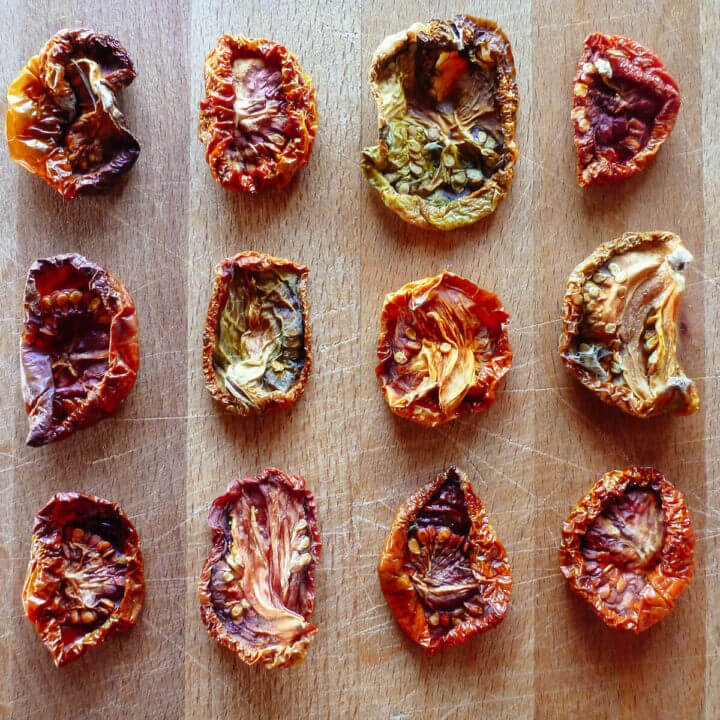
You don't have to dry tomatoes in the sun for days on end. Here's how you can use your oven to dry them in a fraction of the time—but with all of the flavor.
Ingredients
- Ripe tomatoes, halved, quartered, sliced into 1/2- to 3/4-inch wedges, or left whole (if using cherry or grape tomatoes)
- Coarse sea salt
- Sprigs of fresh herbs (optional)
Instructions
- Preheat your oven to its lowest temperature setting (between 175°F to 190°F—sometimes this will simply be the "warm" setting). If your oven's lowest setting is 200°F or more, you can prop the door open slightly with a wooden utensil to regulate temperature and moisture evaporation.
- Arrange your tomatoes on large baking sheets, skin sides down and barely touching. If you have oven-safe cooling racks, you can place them over the baking sheets first for maximum air flow around the tomatoes, which will speed up the drying process.
- Sprinkle the tomatoes sparingly with salt.
- If using, scatter your favorite herbs on top of the tomatoes.
- Check the oven every couple of hours until the edges of the tomatoes start to curl in and the centers start to pucker. At this point, you'll need to check every hour or less. You want a raisin-y texture—fully dry, but still pliable and leathery to the touch. You'll know the tomatoes are fully dry when you press down on them and no juices seep out. Be careful that you don't dry them too much that they become brittle.
- Smaller chunks of tomatoes will dry faster than larger and thicker ones, so pick these off the baking sheets individually and leave them out to cool. When all the tomatoes have finished drying, remove them from the oven and allow the batch to cool completely.
- Once fully dry, store the tomatoes in clean jars in a cool, dark place (dry-packing method) OR pack the oven-dried tomatoes in good-quality extra-virgin olive oil in a jar (oil-packing method) and store the jar in the refrigerator.
Notes
Small, dense tomatoes are most ideal for oven drying, sun drying, and dehydrating. These include pear-shaped varieties and plum tomatoes (also called Roma or paste tomatoes). A particular heirloom grape variety called Principe Borghese is especially well-suited to drying because its meaty texture is drier than most. But, I've had great success with petite round tomatoes as well as larger slicing types, so use what you have!
At 175°F, my tomatoes took 12 hours to thoroughly dry, but the process may take anywhere from 6 to 24 hours. (Your mileage will vary based on the type of oven used.)
More tomato recipes to try:
- Easy Peasy Homemade Tomato Sauce (No Peeling Required)
- Summer Means Salsa (Spicy Fermented Salsa, That Is)
- 4 Ways to Pickled Green Tomatoes
- Roasted Green Tomato Salsa Verde
- Bacon, Chicken, and Green Tomato Soup
- Can You Eat Tomato Leaves? The Answer Will Surprise You
This post updated from an article that originally appeared on September 27, 2011.
View the Web Story on making sun-dried tomatoes in the oven.


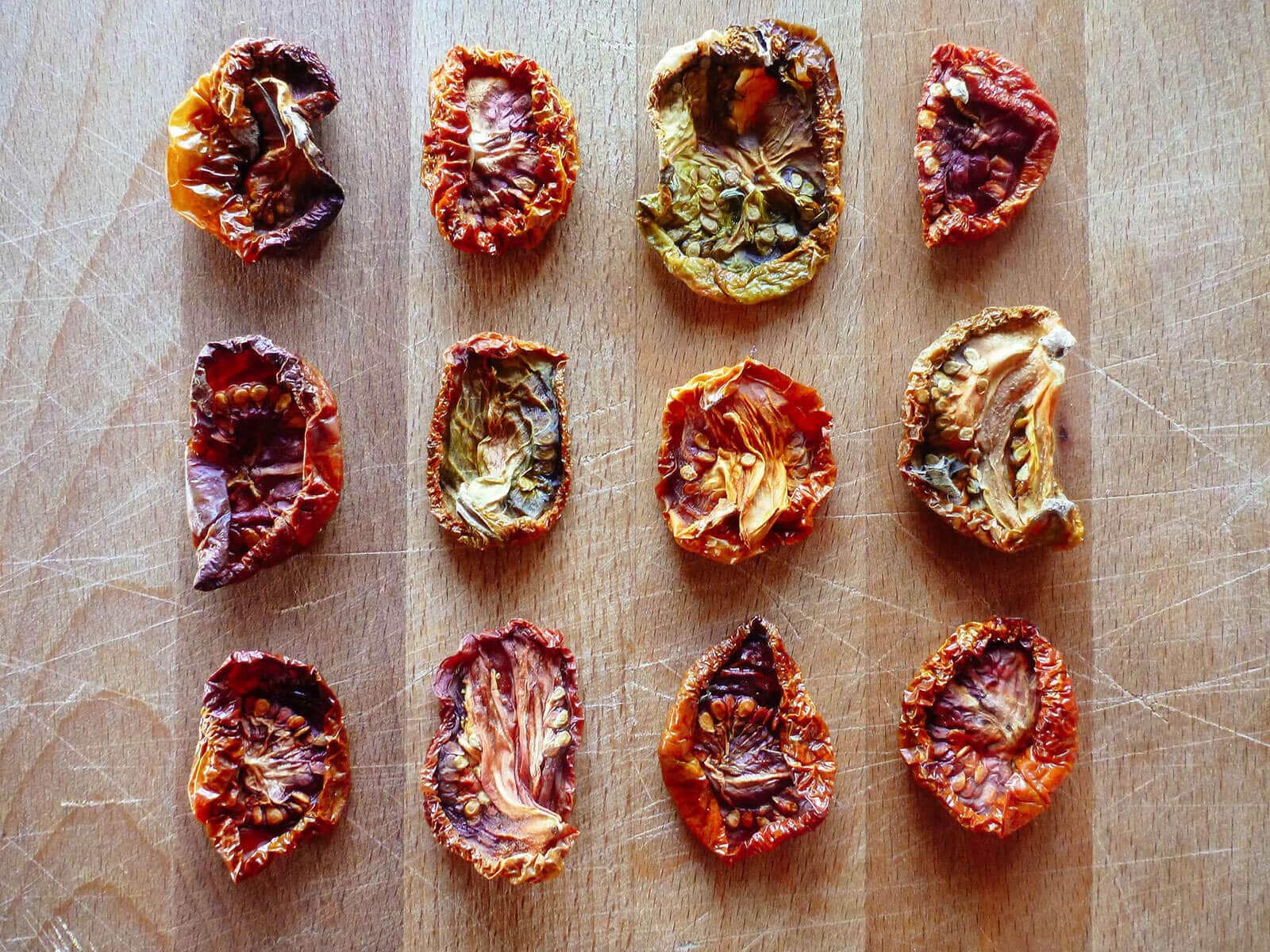













I speed things up and improve the flavor by cutting or slicing the tomatoes and then adding salt, pepper, sugar, and citric acid. This begins to draw some of the liquid out and beans. There’s less liquid to have to evaporate then I will rosemary or even more salt pepper remaining liquid Can be used in many different ways is for soup is a drink juice to make sandwiches and sometimes easier to use a little while spray hair whatever I’m going to be drying it you can pick up those little bags to keep something dry Amazon are you complaining like a snack
Hey, Garden Betty, I’m so excited. We scored a bunch of end of season tomatoes at our farmers market. No more room in the freezer so I decided to give your oven dried tomatoes a try. Wow, they turned out so perfect. The smell, taste and texture are better than anything I’ve bought in the store. Thank you for the great advice! Love your articles!
I have also heard you can put in a food processor and make a powder, after drying the tomatoes. Wait til they are cooled to put in a jar. When water is added to the powder at 3 different consistency’s you can have Tom paste, Tom sauce or tomatoes juice. What a great idea.
Principe borghese right off the vine are delicious. Each one has its own flavor. They’re addictive.
I’m working on my second batch to oil pack.
And yes it’s funny how a sink full of these mini tomatoes only make a small jar.
I eat them out of hand, Garden Betty. I eat them out of hand, with a big happy smile on my face. I haven’t actually done this before this year, so I’m excited about the possibilities or wintertime snacking and sauce-making with the ones that I don’t eat now!
Ohhhh I know, they’re like candy when they get to this point!
And if you don’t have a dehydrator, you can make them in the oven! http://t.co/MacRl2wfty
I made a couple trays of these because I just had pounds & pounds of “egg yolk” (yellow-green ping-pong size) tomatoes. My first experiment was to slice the tomatoes … they shrink down to nickel or quarter-sizes intensely tasty bits! Tomorrow I’m going to try quartering/halving and see how those come out. I had about half a tray I forgot were in the oven and they ended up a bit more dried than they should have been — not unusable, though! I used my kitchen shears to snip them into little bits, and the flavor is akin to bacon bits – with a fraction of the calories, salt and fat. 🙂
I’ve had a few of those extra dry bits before (usually the ones too close to the oven walls) and find that they’re exceptionally tasty in sauce! I blend them up with my other ingredients, or I make tapenade with them. Crazy good!
try using a serrated peeler to remove skins and extract seeds before roasting/drying. You’ll need meaty ones to do this but it gets rid of the skins (which some people dislike) and the bitterness of gelatinous seed coating for an even more intense tomato flavor & sweetness
I’ve never found my tomatoes (or the seed coating) to be bitter at all; I suppose it depends on the varieties you’re drying. All the heirlooms I’ve tried have been as sweet as can be.
cool! great tutorial. I will have to try this next year!